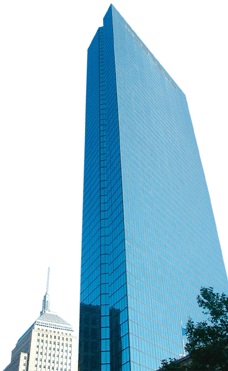
 Today,
the 60-story John Hancock Tower is the tallest building in New England and is considered
one of the Hub’s greatest works of architecture. But perhaps no building in
the world has had a more controversial history than this elegant, sliver of glass
skyscraper.
Today,
the 60-story John Hancock Tower is the tallest building in New England and is considered
one of the Hub’s greatest works of architecture. But perhaps no building in
the world has had a more controversial history than this elegant, sliver of glass
skyscraper.
From the time when it was first proposed in 1960s, the 790-foot building was greeted with unprecedented public disdain, partially because of its placement in Copley Square, adjacent to the other pillars of local architecture, Trinity Church and the Boston Public Library. Critics derided its design by Henry Cobb of I.M. Pei Associates as “flamboyant” and “overbearing.” After construction began in 1968, ground settling almost caved-in its next-door neighbors.
Then in the winter of 1972, fierce winds struck and the building’s giant, 500-pound window panes began crashing to the ground, creating a sea of shattered glass on the sidewalk. During high winds, the area was roped off and wooden canopies were erected. Plywood began to cover much of the building’s facade, prompting Bostonians to mock the structure as “The Plywood Palace.” Remarkably, though, no one was killed.
Engineers spent countless hours studying the problem. Eventually, a defect in the lead soldering that held the windows in place was revealed as the culprit, and all of the building’s 10,344 panes had to be replaced at a cost of nearly $8 million.
Thanks to all of the scrutiny, several other catastrophic scenarios were uncovered: one, that instead of swaying back and forth during high winds, the building could end up twisting itself apart. Or even more horrifying, that under “extreme and rare wind conditions which could possibly occur during the next 100 years,” the building could potentially topple over—on its narrow side! Three-hundred ton weights were place on the 58th floor and the building was reinforced with millions of dollars in steel strutting. All of this havoc ended up delaying the Hancock’s opening from 1971 to 1976.
In the intervening 27 years, the Hancock’s fortunes have changed dramatically.
The skyscraper has gone from one of Boston’s most reviled projects to one
of its most revered landmarks. It’s now praised for its quiet tranquility
that deflects attention to the nearby architectural jewels in Copley Square. From
afar, it is perhaps one of the most beautifully situated skyscrapers in the world,
rising gracefully over the Back Bay. After it opened, the Boston Society of Architects
gave it a medal for the best new work of architecture in Boston. More recently,
a 1994 Boston Globe poll of local architects rated it the city’s third best
work of architecture, after its venerable neighbors, Trinity Church and the BPL.
Vindication, indeed.
—Chris Wallenberg